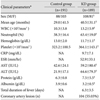1. Yeo JS, Choi JW. Effectiveness of medium-dose intravenous immunoglobulin (1 g/kg) in the treatment of Kawasaki disease. Korean Circ J. 2010. 40:81–85.
2. Lee SJ, Ahn HM, Yoo JH, Hong YM. Carotid intima-media thickness and pulse wave velocity after recovery from Kawasaki disease. Korean Circ J. 2009. 39:264–269.
3. Wang CL, Wu YT, Liu CA, Kuo HC, Yang KD. Kawasaki disease infection, immunity and genetics. Pediatr Infect Dis J. 2005. 24:998–1004.
4. Fulton DR, Newberger JW. Long-term cardiac sequelae of Kawasaki disease. Curr Rheumatol Rep. 2000. 2:324–329.
5. Kato H, Sugimura T, Akagi T, et al. Long-term consequences of Kawasaki disease: a 10- to 21-year follow-up study of 594 patients. Circulation. 1996. 94:1379–1385.
6. Lloyd AJ, Walker C, Wilkinso M. Kawasaki disease: is it caused by an infectious agent? Br J Biomed Sci. 2001. 58:122–128.
7. Liang SJ, Cheong HI, Noh CI, Yun YS. Role of anti-endothelial cell antibody in the development of coronary arterial lesions in Kawasaki disease. Korean Circ J. 2006. 36:723–731.
8. Maury CP, Salo E, Pelkonen D. Circulating interleukin-1 beta in patients with Kawasaki disease. N Engl J Med. 1988. 319:1670–1671.
9. Ueno Y, Takano N, Kanegane H, et al. The acute phase nature of interluekin-6: studies in Kawasaki disease and other febrile illness. Clin Exp Immunol. 1989. 76:337–342.
10. Hirano T, Akira S, Taga T, Kishimoto T. Biological and clinical aspects of interluekin-6. Immunol Today. 1990. 11:443–449.
11. Tanaka C, Mannami T, Kamide K, et al. Single nucleotide polymorphisms in the interleukin-6 gene associated with blood pressure and atherosclerosis in a Japanese general population. Hypertens Res. 2005. 28:35–41.
12. Kim MK, Kim DS. The interleukin-6 level in Kawasaki disease. J Korean Pediatr Soc. 1992. 35:515–526.
13. Research Committee on Kawasaki Disease. Report of Subcommittee on Standardization of Diagnostic Criteria and Reporting of Coronary Artery Lesions in Kawasaki Disease. 1984. Tokyo, Japan: Ministry of Health and Welfare.
14. Hong YM, Jin HS, Park IS, Hong SJ. Association of the matrix metalloproteinase-3 (-439C/G) gene polymorphism with Kawasaki disease in Korean children. Heart Vessels. 2008. 23:341–347.
15. Hirao J, Hibi S, Andoh T, Ichimura T. High levels of circulating inter-leukin-4 and interleukin-10 in Kawasaki disease. Int Arch Allergy Immunol. 1997. 112:152–156.
16. Cheung YF, Huang GY, Chen CB, et al. Inflammatory gene polymorphisms and susceptibility to Kawasaki disease and its arterial sequelae. Pediatrics. 2008. 122:e608–e614.
17. Leung DY, Geha RS, Newberger JW, et al. Two monokines, interleukin-1 and tumor necrosis factor, render cultured vascular endothelial cells susceptible to lysis by antibodies circulating during Kawasaki syndrome. J Exp Med. 1986. 164:1958–1972.
18. Hata A, Onouchi Y. Susceptibility genes for Kawasaki disease: toward implementation of personalized medicine. J Hum Genet. 2009. 54:67–73.
19. Blake GJ, Ridker PM. Inflammatory bio-markers and cardiovascular risk prediction. J Intern Med. 2002. 252:283–294.
20. Zee RY, Cook NR, Cheng S, et al. Polymorphism in the P seletin and interleukin-4 genes as determinants of stroke: a population-based, prospective genetic analysis. Hum Mol Genet. 2004. 13:389–396.
21. Chapman CM, Beilby JP, Humphries SE, Palmer LJ, Thompson PL, Hung J. Association of an allelic variant of interleukin-6 with subclinical carotid atherosclerosis in an Australian community population. Eur Heart J. 2003. 24:1494–1499.
22. Jibiki T, Terai M, Shima M, et al. Monocyte chemoattractant protein 1 gene regulatory region polymorphism and serum levels of monocyte chemoattractant protein 1 in Japanese patients with Kawasaki disease. Arthritis Rheum. 2001. 44:2211–2212.
23. Fishman D, Faulds G, Jeffery R, et al. The effect of novel polymorphism in the interleukin-6 (IL-6) gene on IL-6 transcription and plasma IL-6 levels, and an association with systemic onset juvenile chronic arthritis. J Clin Invest. 1998. 102:1369–1376.
24. Burns JC, Shimizu C, Shike H, et al. Family-based association analysis implications IL-4 in susceptibility to Kawasaki disease. Genes Immun. 2005. 6:438–444.
25. Jin HS, Kim HB, Kim BS, et al. The IL-10 (-627 A/C) gene polymorphism may be associated with coronary aneurysms and low albumin in Korean children with Kawasaki disease. Pediatr Res. 2007. 61:584–587.
26. Linker-Israeli M, Wallace DJ, Prehn JL, Nand R, Li L, Klinenberg JR. A greater variability in the 3'flanking region of the IL-6 gene in patients with systemic lupus erythematosus (SLE). Autoimmunity. 1996. 23:199–209.
27. Papassotiropoulos A, Bagli M, Jessen F, et al. A genetic variation of the inflammatory cytokine interleukin-6 delays the initial onset and reduces the risk for sporadic Alzheimer's disease. Ann Neurol. 1999. 45:666–668.
28. Morgan L, Cooper J, Montgomery H, Kitchen N, Humphries SE. The interleukin-6 gene -174G>C and -572G>C promoter polymorphisms are related to cerebral aneurysms. J Neurol Neurosurg Psychiatry. 2006. 77:915–917.
29. Sohn MH, Hur MW, Kim DS. Interleukin-6 gene gene polymorphism is not associated with Kawasaki disease. Genes Immun. 2001. 2:357–362.









 PDF
PDF ePub
ePub Citation
Citation Print
Print



 XML Download
XML Download